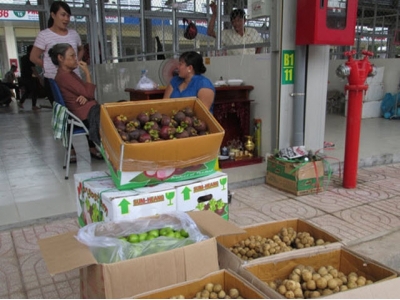Vietnam re-exports Thai fruit to China

In the first nine months of the year, Vietnam imported $680 million worth of fruits from Thailand, or 60 percent of total fruit imports, according to the General Department of Customs (GDC). And by the end of August 2017, $817.9 million worth of fruit had been sold to China, 73 percent of which was from Thailand.
China is among the biggest export markets for Vietnam’s fruit with the growth rate in the first eight months of the year at 60.2 percent.
Meanwhile,Thailand has taken over China’s position as the No 1 seller of fruit and vegetables to Vietnam, accounting for 60.7 percent of Vietnam’s imports. China, which is now in the second position, accounts for 15.7 percent only.
The Ministry of Agriculture and Rural Development (MARD) said that fruit imports from Thailand have been increasing rapidly, but 90 percent of the imports have been re-exported to China.
The ministry said that China has a high demand for fruit imports from Thailand. However, Thailand has recently restricted exports to China, resulting in a short supply in the Chinese market.
Fruit imports from Thailand have been increasing rapidly, but 90 percent of the imports have been re-exported to China.
However, due to problems in domestic production organization, Vietnam’s fruits cannot be sold to China. Vietnamese businesses have to buy fruit from Thailand to export to China.
The owner of a fruit trading company in Hanoi said that Vietnamese businesses do not cooperate with Vietnamese farmers to scale up production and boost sales, but simply import Thai fruits for re-export to China, the easiest way to make a profit.
An analyst said that imported Thai fruits for export must be listed among ‘temporary imports for re-export later’.
Bui Trinh, an economist, said if counting the ‘temporary imports for re-export later’, policy makers and economists would not have reliable figures about domestic production and exports. They will be misled when predicting market demand.
“The illusion about export achievements will lead to overproduction and oversupply, which will make farmers suffer,” he said.
Trinh also pointed out that there is no common concept about import prices. Sometimes FOB prices are quoted, but in other cases, CIF prices are reported.
A report showed Vietnam exported $360 million worth of fruits and vegetables in July, and $2.03 billion in the first seven months of this year, an increase of 48.9 percent, compared with the same period last year.
Meanwhile, it spent $216 million to import fruits and vegetables in July and $852 million in the first seven months, doubling the figure in the same period last year. The country’s largest export markets were Thailand and China, with a market share of 57 percent and 16.8 percent, respectively.
Related news
 Vietnam seeks to export pork
Vietnam seeks to export pork Local pig farmers and processors are working on plans including building disease-free areas to export pork next year.
 APEC increases investment in agriculture, rural areas
APEC increases investment in agriculture, rural areas Vietnam, other APEC economies, and international organizations have paid special attention to ensure sustainable agricultural and rural development
 Vietnamese fruit, vegetable exporters seek opportunities in EU
Vietnamese fruit, vegetable exporters seek opportunities in EU Fruit and vegetable exports led to a turnover of US$2.64 billion for the country over the past nine months, a year-on-year surge of 44.2 per cent